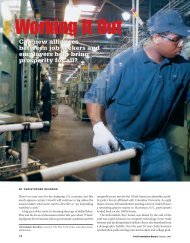9challenges by expanding and continually refining <strong>the</strong>ir recruitment strategies. <strong>In</strong> <strong>the</strong> end, <strong>the</strong>four random assignment sites enrolled a total of 2,360 people, or 74 percent of <strong>the</strong>ir originalgoal. Chicago enrolled 845 participants—56 percent of its original goal.At some sites, staff realized early on that <strong>the</strong> applicants coming to <strong>the</strong> program were not qualifiedfor <strong>the</strong> jobs <strong>the</strong>y had developed. At all sites, staff found that many applicants were lackingsome of <strong>the</strong> basic skills needed to obtain and retain a job. The Bridges programs respondedby providing limited job preparation services, such as workshops on attitudes, dress, communicationin <strong>the</strong> workplace and interviewing techniques. At <strong>the</strong> random assignment sites,760, or 64 percent of <strong>the</strong> 1,183 people eligible to receive Bridges services, obtained employmentthrough <strong>the</strong> Bridges to Work program. At Chicago, 607 people, or 72 percent of those enrolled,obtained employment through <strong>the</strong> program.Four sites continued to provide transportation, placement and retention services to Bridgesto Work participants through January 2001. The demonstration ended in Milwaukee at <strong>the</strong>end of May 2000. Sites offered re-placement services to participants who ei<strong>the</strong>r lost a job orwanted to find a better opportunity at ano<strong>the</strong>r company. The five sites made 389 re-placements.Some of <strong>the</strong> Bridges sites saw many participants leave <strong>the</strong>ir suburban jobs. Three reasonsfor this appear to be that jobs of similar quality were available in some central cities,some sites had to curtail <strong>the</strong>ir transportation services to reduce costs, and <strong>the</strong> participantswho remained unemployed lacked basic employment skills and <strong>the</strong> resources needed toretain a job. Retention in suburban jobs was highest in Baltimore where <strong>the</strong> wage differentialbetween city and suburban jobs appeared to be greater; transportation services were available24 hours a day, seven days a week; and <strong>the</strong> program had developed a network of socialservice providers that offered support to <strong>the</strong> participants.The Bridges to Work demonstration concluded at <strong>the</strong> end of January 2001. Data collectionon <strong>the</strong> follow-up survey will continue through Spring 2001. Two of <strong>the</strong> five sites, Baltimore andSt. Louis, have secured funding to continue providing employment and transportation servicesto link city residents to suburban jobs.
10BETWEEN THEORY AND PRACTICEThere’s more to it than having some vansand some drivers and knowing how to getfrom one point to ano<strong>the</strong>r. If it were thatsimple, everyone would be doing it.—Roz Staples-StreeterThe Reality of Reverse CommutingBridges to Work was designed to testwhe<strong>the</strong>r transportation could span <strong>the</strong>gap between inner-city job seekers andsuburban employers. P/PV’s research hadshown that in six of <strong>the</strong> nation’s eightlargest metropolitan regions, more thantwo-thirds of <strong>the</strong> jobs created during <strong>the</strong>1980s were located in <strong>the</strong> suburbs. At <strong>the</strong>same time, poverty rates in <strong>the</strong> inner citiesreached levels two to five times higherthan in <strong>the</strong>ir corresponding suburbs,where workers tended to receive betterwages and benefits.Reverse commuting offered a possiblesolution to this spatial mismatch. The ideawas to identify job-ready adults in selectedurban neighborhoods, help <strong>the</strong>m findjobs close toge<strong>the</strong>r in <strong>the</strong> suburbs, andgive <strong>the</strong>m rides to and from work. Thearchitects of Bridges also envisioned arange of support services to make <strong>the</strong>project a viable option for prospectiveparticipants. For example, workers wereto be guaranteed a ride home in case ofemergency, such as for a sick child.The project directors for <strong>the</strong> five demonstrationsites still largely agree with thisstrategy. Experience, though, has heightened<strong>the</strong>ir sense that while transportationmay be <strong>the</strong> most apparent obstacle togainful employment in <strong>the</strong> suburbs, it isby no means <strong>the</strong> only one. Withoutexception, <strong>the</strong> sites have run up against aslew of social and systemic barriers thatincluded burdensome child care arrangements;limited literacy; and problemscollaborating with o<strong>the</strong>r agencies thatwere caused by <strong>the</strong> mechanics of welfarereform, <strong>the</strong> research methodology andlocal politics.Some project directors, notably Denver’sMandi Huser, have found that <strong>the</strong> suburbanjobs tended to be quite spreadout, making transportation more costlyand complicated than expected. LikeMilwaukee’s David Wilson, she has alsolearned that suburban jobs do not alwayspay well enough to warrant a long commute.<strong>In</strong> Baltimore, transportation hasbeen somewhat easier to arrange. Thetrickiest part <strong>the</strong>re, says Linda Stewart-Byrd,has been grappling with recruitment,placement and o<strong>the</strong>r employment issues.Perhaps <strong>the</strong> greatest constant has been<strong>the</strong> resourcefulness that all five sites havedisplayed in keeping <strong>the</strong> demonstrationon track. The project directors and <strong>the</strong>irstaffs have frequently raced <strong>the</strong> clock todevise new ways to identify employers,recruit workers, and get <strong>the</strong>m to <strong>the</strong>irjobs on time within <strong>the</strong> constraints of <strong>the</strong>original design. Although <strong>the</strong> overallnumber of people recruited and placed injobs was not as high as expected, Bridgesis proving successful in generating crucialrefinements that could enable reversecommuteprograms to stand up to <strong>the</strong>strains and stresses of <strong>the</strong> real world.Linda Stewart-Byrd (Baltimore): I think <strong>the</strong>potential is extraordinary. There are a lotof things that need to be worked out asfar as <strong>the</strong> strategy and financing of Bridges,but overall it’s a great concept and it giveshope. Some participants say it’s an opportunityfor <strong>the</strong>m to change <strong>the</strong>ir lives—toget jobs with upward mobility, careersthat have meaning, a livable wage, andbenefits so <strong>the</strong>y can actually take care of<strong>the</strong>ir families. <strong>In</strong> <strong>the</strong> Baltimore region,it’s harder to find those types of jobs in<strong>the</strong> city if you have limited skills.Robert Carter (Chicago): I think it’s asound strategy, too. We’ve had a lot ofexperience with using large vehicles, likebuses, to transport people in Chicago. But<strong>the</strong>re are some severe limitations to that,









